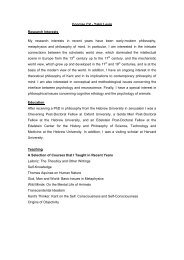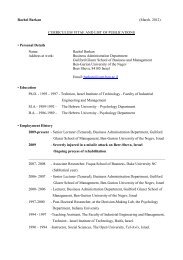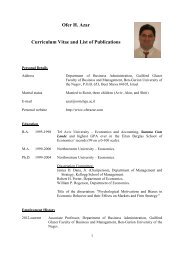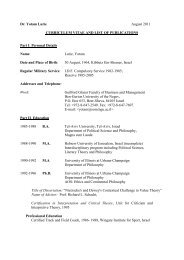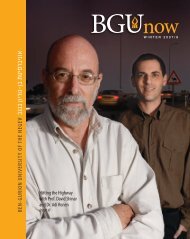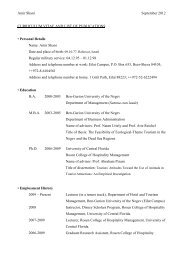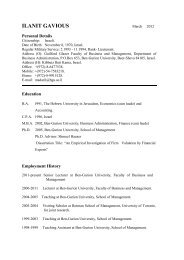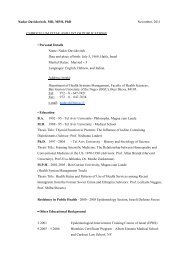Book of Abstracts
Book of Abstracts
Book of Abstracts
You also want an ePaper? Increase the reach of your titles
YUMPU automatically turns print PDFs into web optimized ePapers that Google loves.
26<br />
Platform, June 2012). Large quantities <strong>of</strong> water are needed to produce any agricultural product--food, feed, fiber,<br />
fuel-- and any additional savings allow us what we need most – getting more with less input.<br />
By mid-century, the world will need 100% more food than is produced today. It is estimated that about 70% <strong>of</strong> the<br />
increase in food production is expected to come from higher yields. Drip irrigation is, then, not an option but a real<br />
need. Our mission is to leverage the potential <strong>of</strong> drip and micro-irrigation to efficiently employ the world’s most<br />
precious resources--arable land, water and energy--and by doing that, to ensure greater food security for the global<br />
population while preserving the environment. More than 80% <strong>of</strong> the global agricultural land is not irrigated (less<br />
than 20% is irrigated, supplying 40% <strong>of</strong> the world's food). Disappointingly, just 4%-5% is irrigated efficiently with<br />
drip-irrigation systems. We know that irrigation is a key component in the required water revolution. Drip-irrigation<br />
is, therefore, a key component in sustainable water management solutions. This is the moment to introduce the 2 nd<br />
drip-irrigation revolution – the nano-irrigation system.<br />
Study <strong>of</strong> evapotranspiration for estimation <strong>of</strong> harvested water storage efficiency<br />
G. Carmi, B. Rewald, and P. Berliner; The French Associates Institute for Agriculture & Biotechnology <strong>of</strong> Dryland;<br />
The Jacob Blaustein Institutes for Desert Research; Ben-Gurion University <strong>of</strong> the Negev; Sede Boqer, Israel;<br />
genadi@bgu.ac.il<br />
Water is a primary limiting factor to agricultural development in arid and semi-arid areas. In these regions, much <strong>of</strong><br />
the annual rainfall occurs as a result <strong>of</strong> a few intensive convective storms. A technique <strong>of</strong> run<strong>of</strong>f collecting, known<br />
as run<strong>of</strong>f harvesting, may be used for food and fuel production and flood and erosion control, as well as for<br />
landscape development. The efficiency <strong>of</strong> run<strong>of</strong>f generation is an important issue in water harvesting schemes, but<br />
the critical component is the water availability to the tree/crop planted in the run<strong>of</strong>f receiving area. The area in<br />
which the run<strong>of</strong>f water is collected is usually a depression located in the immediate vicinity <strong>of</strong> the run<strong>of</strong>f generating<br />
area. Evaporative losses play a major role in determining the amount <strong>of</strong> water that will be available to the plants<br />
and/or trees planted in the shallow depressions. We hypothesize that when water is collected in deep trenches, it<br />
infiltrates through the trenches’ bottom and into the surrounding walls as well, and the evaporative losses will be<br />
smaller than those that can be expected for shallow depressions. The experiment was carried out in Sede Boker,<br />
Israel from January 2011 to January 2012. The effects <strong>of</strong> water collection in i) deep trenches and ii)<br />
microcatchments were investigated; each treatment was replicated three times. Three olive trees were planted at the<br />
bottom <strong>of</strong> the 12 m long, 1 m deep and 1 m wide trenches. Microcatchments had a cross-sectional area <strong>of</strong> 9 m 2 (3x3<br />
m) with one olive tree planted in the middle. The trenches and microcatchments were flooded simultaneously in<br />
April 2011 with 1.5 m 3 water per tree; the soil water content was continuously monitored through the access tubes<br />
using a neutron probe. To estimate transpiration, stem sap-flow was measured by a Granier system.<br />
Evapotranspiration for each trench and microcatchment was calculated by the mass balance method. Transpiration<br />
was deducted from the resulted evapotranspiration. Total evapotranspiration in the trenches was 50% <strong>of</strong> the water<br />
amount applied by flooding, while microcatchments lost 132% (flooded water plus additional soil water left after the<br />
rainy season). The results show that water losses from microcatchments were significantly higher than those from<br />
the trenches, and that evaporation <strong>of</strong> the collected water in trenches was more effectively prevented.<br />
Estimating precipitation and actual evaporation from precision lysimeter measurements<br />
Wolfgang Durner; Institute <strong>of</strong> Geoecology; TU Braunschweig; Braunschweig, Germany;<br />
w.durner@tu-bs.de<br />
Lysimeters are excellent tools for obtaining reliable data about seepage water quantity and quality. Large weighable<br />
lysimeters, furthermore, permit the quantification <strong>of</strong> the water balance <strong>of</strong> the soil and the precise measurement <strong>of</strong><br />
water exchange at both the soil-atmosphere interface, by rain, dew, fog, and rime, and the flux below the root zone<br />
toward the groundwater. If well embedded into a similarly vegetated environment, they avoid errors made by<br />
traditional measurement systems, such as the wind error <strong>of</strong> Hellman rain samplers, or the island error <strong>of</strong> class-A<br />
pans, or the heterogeneity error that affects any readings from in situ instrumentation <strong>of</strong> soil water state variables. If<br />
the amount <strong>of</strong> seepage water is recorded separately, the time series <strong>of</strong> the lysimeter mass represents the other parts<br />
<strong>of</strong> the water balance equation: increasing mass shows precipitation amount, decreasing mass is the effect <strong>of</strong><br />
evapotranspiration, the mass difference in the evaluation period indicates the change <strong>of</strong> stored water volume.



